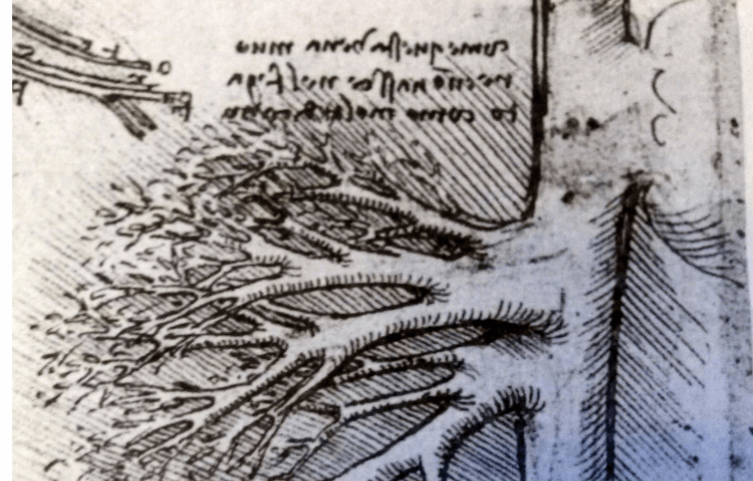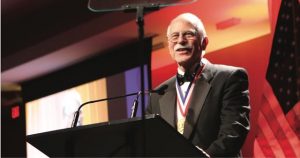In the year 1300, Pope Boniface VIII issued a papal decree, De Sepulturis, which outlawed various methods of lightening the bodies of the diseased for the ease of transport. These methods–common among the Crusaders in the Near East–included the removal of flesh by boiling as well as dismemberment, which also allowed for bodies to be stored in more compact containers. For years after, De Sepulturis was misinterpreted to include the condemnation of anatomical dissection, and for years the study of anatomy would suffer from this misconception. Over time, however, anatomical dissections regained popularity and became important not only to scientists of the body, but also to artists like Michelangelo and Leonardo Da Vinci. However, even into the 1500’s, anatomical sketches were considered distractions unworthy of publication in anatomy textbooks.1

Leonardo Da Vinci, the famous Italian polymath most commonly known today for his painting Mona Lisa, was not renowned for his anatomical diagrams in his time; but unlike his artist peers, his illustrations of the human structure went far beyond the superficial arteries and musculature. While his diagrams do not indicate formal training or even first-hand experience at dissection, Da Vinci began sketching the human anatomy at four different perspectives, simulating a three-dimensional model. Furthermore, Da Vinci sketched the bodily organs, and even wrote about their anatomical functions. It seems that it was Da Vinci’s unquenchable thirst for knowledge and inquiry that drove him to observe deeper than what most deemed necessary. This was characteristic of Leonardo from a young age. Indeed, in 1478, when Leonardo began his career in Florence under the Compagnia de San Luca, he was just sixteen. His early loves for mathematics and mechanics were maintained throughout his life and consistently influenced his vision of the world.4;

Vision was a key aspect to human knowledge to Da Vinci. Being a man of many talents and interests, Da Vinci was drawn to many occupations, and in 1478, after recommending himself to the Duke of Milan, he was made a royal appointee to the duke, Lodovico Sforza, as chief military engineer. In his letter of self-recommendation, Da Vinci referred to himself not only as an artist, but also as a mathematician, architect, and engineer. One of Da Vinci’s first tasks in Milan was to supervise the construction of the Cathedral at Pavia, which would become one of the largest cathedrals in the world. However, it is reported that Da Vinci became so immersed in the theoretical aspects of the physical laws and mechanics involved in the construction of the cathedral that his subordinate had to assume leadership on the practical matters of construction. During this time, Da Vinci also began a practice that has allowed historians and enthusiasts to obtain much deeper insight into the course of Da Vinci’s intellectual studies; like many intellectuals of the Renaissance, Da Vinci began cataloging and recording his studies in notebooks. Many of the anatomical sketches that still survive today were contained in such notebooks. Regardless of his official position as chief military engineer, however, Da Vinci’s primary modes of creation were artistic. Indeed, it was in Milan that Da Vinci finished the paintings Madonna of the Rocks, and The Last Supper; both are masterpieces of human expression and artistic style and technique.5
In 1500, Da Vinci left Milan and continued to paint. He spent several years as a vagabond and finished few paintings during these years, although the famous Mona Lisa was among those left unfinished around the year 1503. At the age of sixty-three, he was appointed to the company of the king of France, near Ambroise, where his chief duty was to keep good company to the king. Leonardo spent the last ten years of his life continuing his research in the realm of the physical sciences, and died on May 2, 1519.6
- Leonardo da Vinci, Leonardo Da Vinci on the Human Body: The Anatomical, Physiological, and Embryological Drawings of Leonardo Da Vinci, eds. Charles Donald O’Malley and John Bertrand de Cusance Morant Saunders (New York: H. Schuman, 1952), 13. ↵
- Leonardo da Vinci, Leonardo Da Vinci on the Human Body: The Anatomical, Physiological, and Embryological Drawings of Leonardo Da Vinci, eds. Charles Donald O’Malley and John Bertrand de Cusance Morant Saunders (New York: H. Schuman, 1952), 131. ↵
- Leonardo da Vinci, Leonardo Da Vinci on the Human Body: The Anatomical, Physiological, and Embryological Drawings of Leonardo Da Vinci, eds. Charles Donald O’Malley and John Bertrand de Cusance Morant Saunders (New York: H. Schuman, 1952), 14-16. ↵
- Leonardo da Vinci, Leonardo Da Vinci on the Human Body: The Anatomical, Physiological, and Embryological Drawings of Leonardo Da Vinci, eds. Charles Donald O’Malley and John Bertrand de Cusance Morant Saunders (New York: H. Schuman, 1952), 14-19 ↵
- Leonardo da Vinci, Leonardo Da Vinci on the Human Body: The Anatomical, Physiological, and Embryological Drawings of Leonardo Da Vinci, eds. Charles Donald O’Malley and John Bertrand de Cusance Morant Saunders (New York: H. Schuman, 1952), 18-21; Toby Lester, Da Vinci’s Ghost : Genius, Obsession, and How Leonardo Created the World in His Own Image (New York : Free Press, 2012), 117-121; Salem Press Biographical Encyclopedia, 2016, s.v. “Leonardo Da Vinci,” by James Livingston. ↵
- Salem Press Biographical Encyclopedia, 2016, s.v. “Leonardo Da Vinci,” by James Livingston. ↵



90 comments
Benjamin Arreguin
This article opened up my eyes about Da Vinci and how he influenced people with his artwork. I did not realize how he entered the scientific world with his diagrams, but this is very interesting because he isn’t a name that comes to mind when thinking of scientific innovators of anatomy. His fascination with the human body is unique, and should be more recognized by people who are interested in his life, just how this article depicts him as. This gave me a new perspective of historically great artists and how they were influenced and inspired.
Kailan Pena
This was a great article to read and an obvious pick for me since I love Leonardo Da Vinci. It was great to learn more about the different pursuits that Da Vinci dabbled in and I’m never not amazed at how much Da Vinci did and accomplished, even if he didn’t finish all of his works, as I just learned.
Christopher King
This is a great article that touches base on a number of things but I felt that this could have been much longer and included more information based upon his greater works and inventions. Aside from his art Da Vinci was also known for his inventions such as the Arial Screw which could be considered the first device able to take flight to some degree. I had not realized that he was a military engeneer and that he had enough of an education to give himself a self-recommendation.
Andrew Dominguez
I knew Da Vinci had interest in working in every field he could. I didn’t know these fields included the human anatomy as well. This is incredible since they hired him as an engineer for the largest church ever to be built. His knowledge was so advance for his time. I like you included his famous works, so that people who aren’t informed of Da Vinci can still feel included by knowing these pieces.
Anais Del Rio
This was an interesting article to read because I expected the article to have information on how Da Vinci’s famous art works came to be but instead got information that was more of behind the scenes of his studies. Before reading this, I knew that Da Vinci was a trailblazer for anatomical drawings but I did not expect De Sepulturis to be a direct cause for inaccurate drawings.
Austin Pena
Great read. This article was very enlightening and even corrected on something I was told to be a fact. I was unaware that De Sepulturis never outlawed the dissection of a human body. I was always under the assumption that he had to do these dissections in private or he could face a possible charge against him. Da Vinci was a man who I believe was ahead of his time and after reading this article I stand with that statement, because his thirst for knowledge along with his creative side allowed for him to learn, record, and create things that we would not re-discover or perfect for years to come after his death.
Destiny Flores
I found this article really enlightening. I always recognized Leonardo De Vinci for his work, the Mona Lisa as well as the Vitruvian Man. But never did I know that he was so captivated by the anatomy of man or that he had interests in the engineering field. It’s clear to see he was underestimated, and still is, by many.
Natalia Carroll-Long
I love how your article of Da Vinci doesn’t delve directly into the Mona Lisa because although it is a masterpiece, I think it clouds the capabilities of Da Vinci. I’m glad you pictured his more as a theoretical engineer than just a painter. I knew that he had interests in the human anatomy, but I didn’t know how he was affected by the body lightening technique. I honestly didn’t know that artist went to watch something like that. I find it interesting.
Ezequiel De La Fuente
Your article was enjoyable to read and I like how you added prior information about how dissections and the anatomy were somehow believed to be banned beforehand. I never knew that Da Vinci had so much interest in the human anatomy and what they function of each organ were. Of course, I’ve seen and heard about the Mona Lisa painting, but I’d love to see of the painting that were discussed in this article.
Manuel Aguilera
Granted I have only heard of Da Vinci in certain books and when learning about art and such, I was never given a deep explanation about who he really was. I never knew that he even, for some time, looked towards the anatomy of the human body. Nor was I aware that he did so many more popular paintings such as “The Last Supper”.